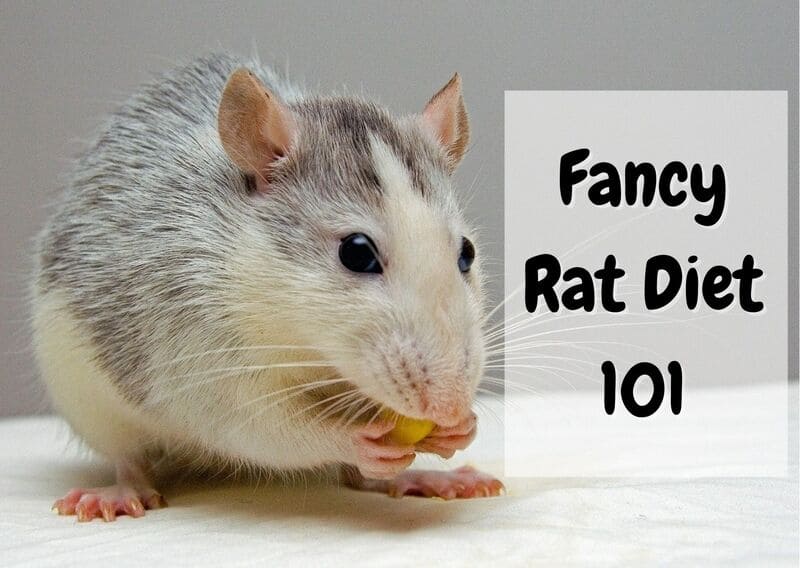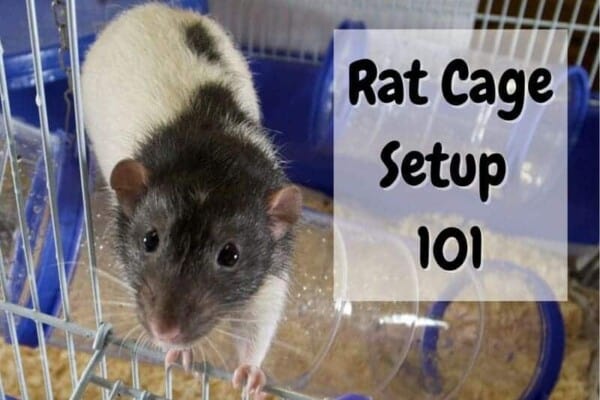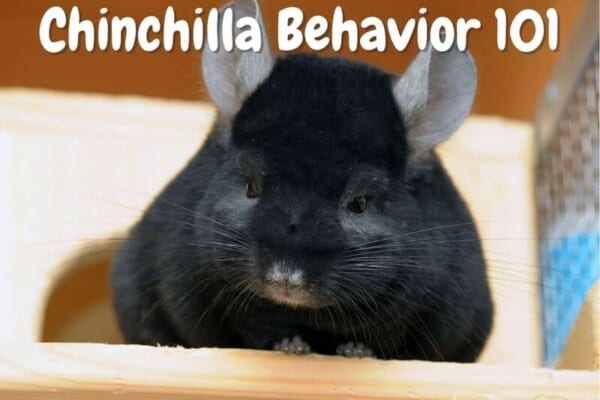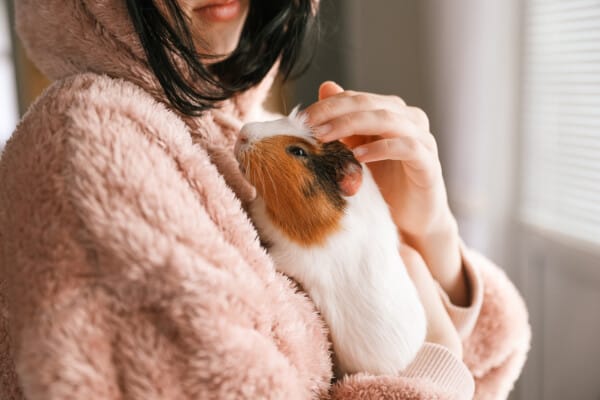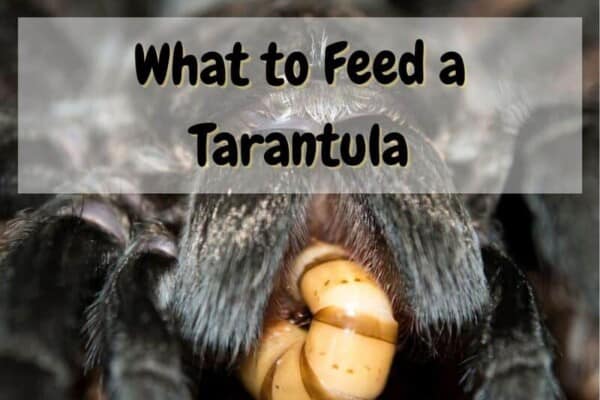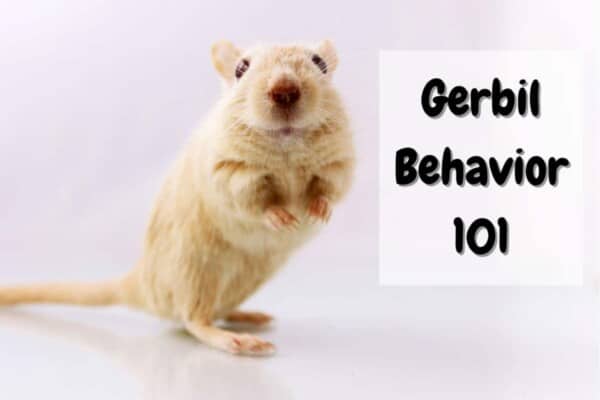The truth about what rats can eat is a testimonial to omnivorous rodents, but there are many important facts you should know about their diet. Because they are omnivores, fancy rats can enjoy a massive variety of food that will give you plenty of choices to add to their diet.
However, some foods will not be healthy for your fancy rat at all. In the wild, undomesticated rats will have a shorter lifespan due to unhealthy eating practices and widespread illnesses. In this comprehensive guide about rat food, we will discuss the best practices for a balanced fancy rat diet.
Food Your Fancy Rat Can Eat
This section will list exactly what your fancy rat can eat no matter what it may include. There are some limitations since you want to provide a well-rounded diet recipe that does include a good percentage of fiber. Rats will be able to survive with a generous amount of pellet grains with added fruits vegetables, and even meats.
1. Vegetables That Are Healthy For Rats
Some veggies mentioned in the following list need to be cooked. These are typically beans, potatoes/sweet potatoes, rhubarb, and artichokes. Potatoes, onions, and shallots should have their skin removed before they are cooked. You can feed your fancy rats:
- Asparagus,
- Aubergine (eggplant),
- beetroot,
- Bok Choy (Pak Choi),
- broad beans,
- broccoli,
- Brussels sprouts,
- butternut squash,
- cannellini beans,
- carrots,
- cauliflower,
- chickpeas,
- collard greens,
- corn (cooked or fresh),
- Courgette (Zucchini),
- cress,
- cucumber
- eggplant,
- French beans,
- garlic,
- haricot beans,
- Jerusalem artichoke,
- kale,
- kidney beans (red beans),
- leek,
- lentils,
- lettuce,
- mange tout,
- marrow,
- Mung beans,
- mushrooms (cooked),
- okra,
- onion (in moderation),
- parsnips (turnip),
- peas
- peppers (green/red/orange)
- potato (no eyes growing or green ones),
- pumpkin,
- red cabbage,
- red onion (in moderation),
- Rocket (arugula),
- rutabaga,
- runner bean (must be cooked),
- Savoy cabbage,
- Shallot (limited amounts),
- Seaweed,
- soya beans
- spring beans,
- string beans,
- spring onion (limited amounts),
- spinach,
- squashes,
- Swede,
- sweet corn,
- sweet peppers,
- sweet potato,
- sugar snap pea,
- Swiss chard,
- tomato,
- turnip,
- watercress,
- zucchini.
2. Fruits fancy rats can eat
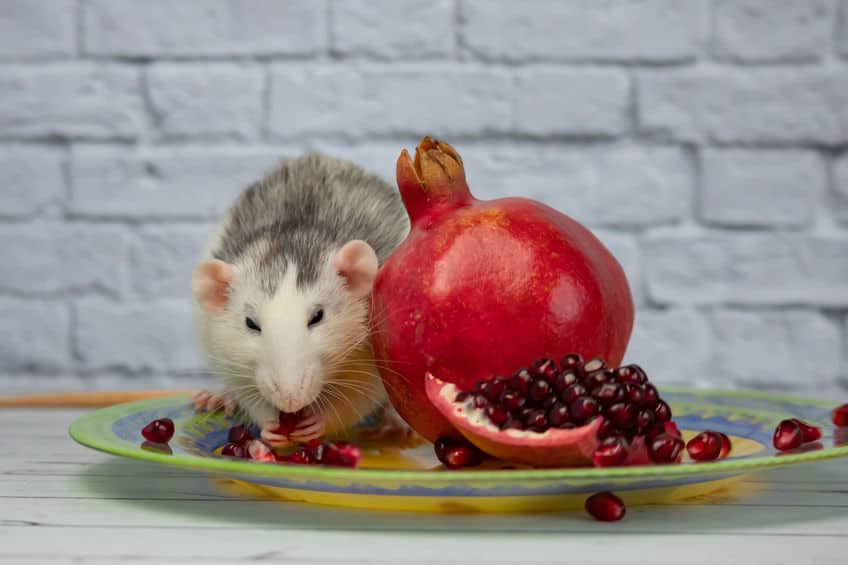
- Apple,
- apricot,
- avocado flesh (no pit),
- banana,
- bilberry,
- blackberry,
- blackcurrant,
- blueberry,
- cantaloupe,
- cherries (no pits),
- Clementine,
- coconut,
- cranberries,
- Damson,
- dates (no seed),
- elderberry,
- figs,
- grapes (seedless),
- honeydew melon,
- kiwi
- kumquat,
- lemon/lime (limited quantities),
- loganberry,
- Mandarin,
- melon,
- mulberry,
- nectarine (no pit),
- orange (in moderation),
- olives (pitted),
- papaya,
- passion fruit,
- peach,
- pears,
- pineapple,
- plums,
- pomegranate,
- pomelo,
- prunes (no seeds),
- raisins
- raspberries,
- redcurrant,
- Rhubarb,
- strawberry,
- tangerine (small amounts)
- watermelon,
- watermelon rind.
3. Herbs and Flowers Your Rat Can Eat
Your rat will enjoy the following herbs:
- basil,
- bamboo shoots,
- bean sprouts,
- chicory,
- clover,
- cilantro (coriander),
- dandelion leaves,
- endive,
- fennel,
- mint,
- parsley,
- sage,
- thyme,
- oregano,
- dill,
- tarragon,
- saffron,
- chervil,
- Rosemary,
- Echinacea (Purple Coneflower),
- Apple blossoms,
- basil flowers.
When it comes to flowers, you may give your fancy rat the following:
- Biennial Clary flowers,
- Busy Lizzie,
- Cape Jasmine,
- Carnations,
- coriander flowers,
- cornflowers,
- Courgette flowers,
- dandelions (flowers and stems),
- dill flowers,
- evening primrose,
- feijoa selloiana flowers,
- fennel flowers,
- fushia flowers,
- gladiolus flowers.
- hibiscus flowers,
- Hollyhock flowers,
- hyssop flowers,
- Japanese basil flowers,
- lavender flowers,
- lemon balm flowers,
- Lilac flowers,
- Marigold flowers,
- marrow flowers,
- mint flowers,
- Bergamot flowers,
- Mooli radish flowers,
- nasturtium leaves and flowers
- spring onion flowers,
- ornamental kale flowers,
- pansy flowers,
- vegetable pea flowers,
- pumpkin flowers,
- purple radish flowers,
- rose flowers,
- rosemary flowers,
- salsify flowers,
- scented pelargonium flowers,
- squash flowers,
- strawberry flowers
- sunflower flowers,
- sweet, cicely flowers,
- sweet mace flowers,
- sweet marjoram flowers,
- viola flowers,
- yucca flowers.
4. Cereals and nuts You Can Give Your Rat
- pasta,
- bread (w/o poppy seeds),
- rice,
- grain,
- wheat,
- durum wheat (Bulgur),
- Couscous,
- rye,
- barley,
- spelt,
- sweet chestnuts,
- almonds,
- sunflower seeds,
- dog biscuits,
- pumpkin seeds,
- Cheerios,
- Chex Mix,
- corn flakes,
- brazil nuts.
- cashews,
- pistachios,
- pecans,
- walnuts,
- hazelnuts,
- sesame seeds,
- flaxseed,
- Chia seeds,
- chickpeas (soaked or cooked),
- lentils (cooked only),
- popcorn,
- buckwheat,
- Quinoa,
- Oats,
- Amaranth,
- Sorghum (Great Millet),
- grain mix,
- noodles,
- macadamia nuts,
- roasted peanuts.
5. Rat Pellets
Rat pellet food from the pet store is perfectly fine for your rat as long as it’s meant for fancy rats. This food will also be found just as easily online per webshops, but always buy from trusted sources.
You can buy bulk rat food that comes in pellet form or cube form. It contains the dietary supplements that your rat will need to have plenty of energy and nutrients. These often contain soybeans, fish meal, fatty acids, and proteins. Some brands will take it a step further and add salmon and brown rice for even more nutritious vitamins. Other brands target baby rats and also adult rats so they get the essential nutrients they need.
6. Meat/Insects/Dairy Rats Can Eat
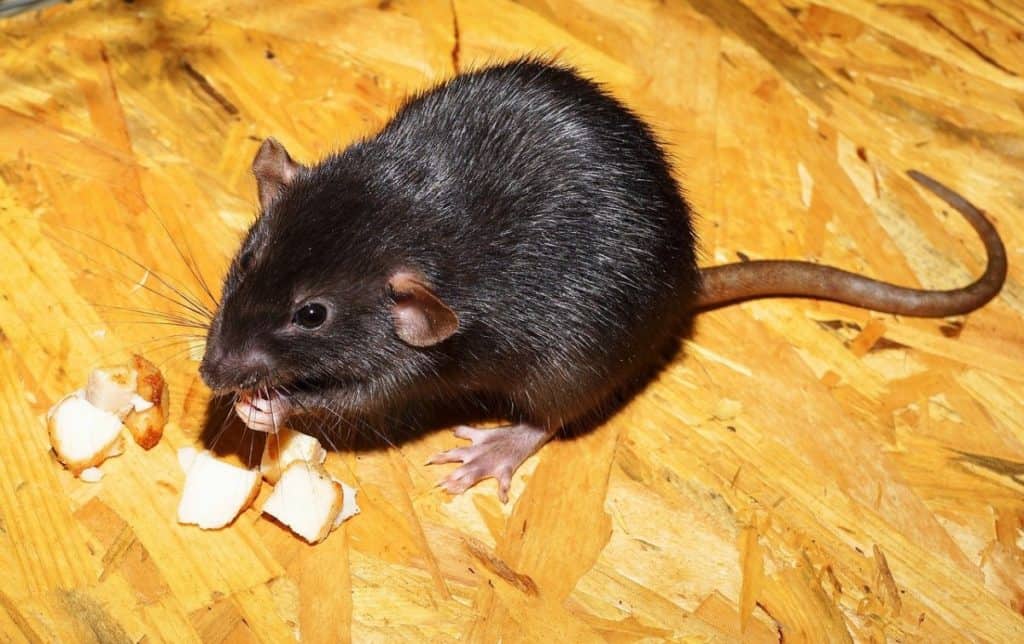
As long as your meat and seafood are cooked, you can give these to your rat. Since there are so many different kinds of meat and seafood, you can give some of the scraps of the day. These can be eyeballs, and other unsavory items you dislike, your rat will simply love it! The complete list includes:
- Any kind of cooked meats,
- chicken,
- turkey,
- fish,
- salmon,
- seafood,
- prawns/shrimp,
- cheese,
- eggs (any kind that is cooked),
- yogurt,
- liver,
- ham,
- mealworms,
- crickets,
- chicken bones,
- cottage cheese,
- milk products,
- canned foods,
- tinned seafood,
- fish eggs (roe),
- crab and lobster (cooked),
- earthworms,
- snails,
- caterpillars.
7. Chewing snacks For Rats
There are many types of fancy rat chew snacks that come in a pellet form or within a block. These can be given as a special treat from time to time, but not daily. Their main food should be pellet food and assortments of meat, fruits, and veggies.
These chewing snacks are rewards you can give when performing a trick you have taught them. Rats can’t vomit, so they need small pieces that they can gnaw on.
8. Wood snacks
These are fine if you choose a wood that is safe for fancy rats to chew on. They can be given individually or built into structures they can climb and gnaw on from time to time. Use helm or rope made from pure helm to tie these structures together. Try using:
- applewood,
- hazelwood,
- ash,
- birch,
- hawthorn,
- elder,
- alder,
- willow,
- cherry plum,
- buddleia,
- beech,
- hornbeam,
- lime or linden,
- Rowan Whitebeam.
There are also woods that you want to avoid and these can make your fancy rat very sick. These will include boxwood, dogwood, laburnum, privet, horse chestnut, eucalyptus, and laurel. These are all extremely toxic woods that can otherwise make your rat sick or die.
Feeding Your Rats: How Much, How Often, and When?
How much food should fancy rats get?
Your adult rat will eat about 12 to 20 grams of dry food which comes to be roughly one to two tablespoons per feeding. The rest is mixed veggies and a good mixture of cooked meat chunks and grain snacks. In total, these portions don’t have to weigh the same amount so it’s all about equal ratios based on spoon size.
How often should you give them food?
You can expect to feed an adult rat twice a day which is perfectly fine for their normal dietary needs. When they are young, you’ll need to feed your rat no more than three times a day. This will continue up to the point of them being 10 weeks old, and then you can limit their food to just twice a day.
What time of the day should you feed them?
The best time is when your rat is at its most active which will be at dusk and dawn. This makes it easier if you go to work in the morning and return in the evening. This schedule also needs to be steady since they will expect their food at these scheduled times.
What To Give a Baby Rat For Food
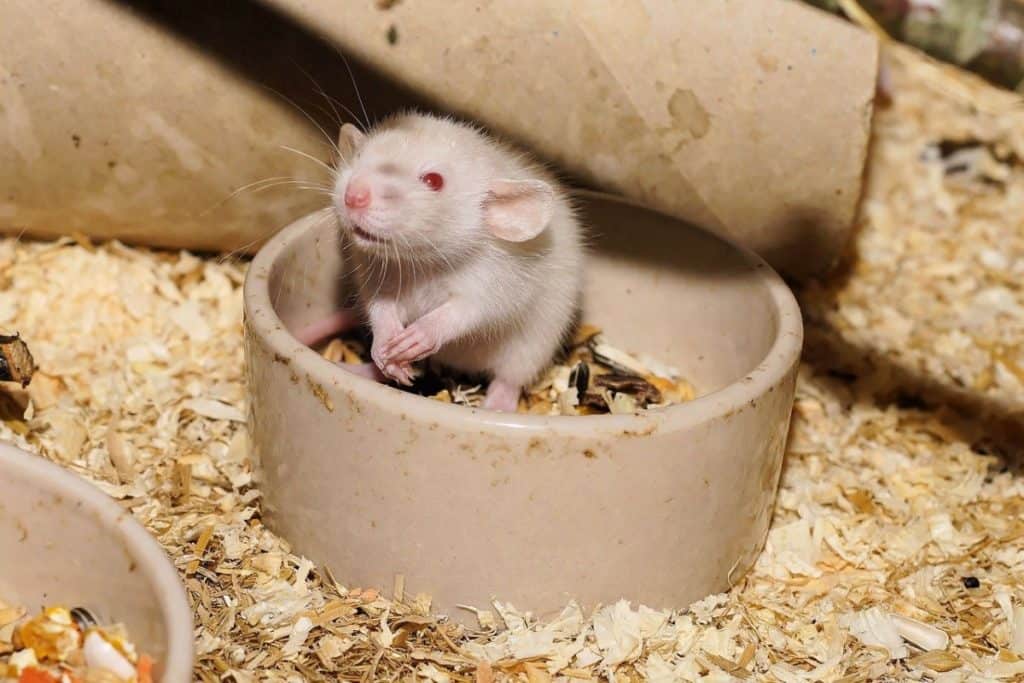
As soon as you get your rat, they’ll be old enough to eat solid foods and they will eat nearly anything that an adult will enjoy, so the list of food provided applied to young rats too. However, their serving size needs to be small enough to hold in their hands, roughly half the size of a sugar cube.
Fancy rat diet Do’s and Don’ts
Now even though we have given you a huge list of food, there are going to be limitations that you have to follow. This is primarily for their health since you have to remember that rats cannot vomit back food. So if they swallow something too big for them to chew, they could easily choke on these food items.
Don’t feed your rat the following foods
- Chocolate,
- poppy seeds,
- licorice,
- candy,
- peanut butter,
- peanuts,
- tofu,
- sugary drinks,
- energy drinks,
- caffeine drinks,
- green bananas,
- blue cheese,
- raw Brussels sprouts,
- raw rhubarb,
- sugary snacks,
- salty snacks,
- uncooked beets,
- uncooked spinach,
- raw sprouts or cabbage,
- citrus fruits with d-limonene
Plants and Flowers That Are Dangerous For Rats
While rats can eat nearly anything, if these are in your garden, you don’t want them to ingest any of these deadly plants or flowers:
- A
- air plant,
- amanita,
- amaryllis,
- American yew,
- Andromeda,
- arum lily,
- Autumn crocus,
- avocado rinds,
- azalea,
- B
- broomcorn grass,
- buckeye,
- buckhorn,
- balsam pear,
- baneberry,
- Bishop’s weed,
- black laurel,
- bloodroot,
- bluebonnet,
- blue-green algae,
- boxwood,
- bracken,
- fern,
- broad beans shell,
- burdock,
- buttercup,
- C
- cacao,
- caladium,
- calla lily,
- camel bush,
- candelabra tree,
- cardinal,
- castor bean,
- chalice vine,
- clematis,
- cocklebur,
- coffee bean,
- Corncockle,
- cowslip,
- D
- daffodil,
- Daphne,
- datura,
- deadly amanita,
- death camus,
- delphinium
- Devil’s ivy,
- dieffenbachia,
- Dutchman’s breeches,
- E
- eggplant leaves,
- elderberry leaves,
- English ivy,
- ergot,
- eucalyptus,
- euonymus,
- F
- false hellebore,
- false henbane,
- flame tree,
- felt plant,
- firethorn,
- foxglove,
- G
- ghostweed,
- Glottidium,
- golden chain,
- ground cherry
- H
- heliotrope,
- hemlock,
- henbane,
- holly,
- honeysuckle,
- horse bean,
- horse chestnut,
- horsetail,
- hyacinth,
- hydrangea,
- I/J
- Indian licorice,
- Indian turnip,
- inkberry,
- iris,
- java bean,
- jasmine,
- Jerusalem cherry,
- Jimsonweed,
- Juniper berry,
- K/L
- Kentucky coffee tree,
- lantana
- larkspur,
- laurel,
- Lily-of-the-valley,
- Lesotho,
- lima bean,
- lobelia,
- locoweed,
- Lords and ladies,
- lupine,
- M
- malanga,
- mandrake,
- marijuana,
- maternity plant,
- Mayapple,
- meadow saffron,
- mescal bean,
- Mexican breadfruit,
- Mexican poppy,
- mistletoe,
- milkweed
- monkshood,
- moonseed,
- morning glory,
- mountain laurel,
- N-P
- narcissus,
- Navy bean,
- nettles,
- nightshade,
- oleander,
- panda plant,
- Peires,
- pencil tree,
- periwinkle,
- philodendrons,
- pigweed,
- poinsettia,
- poison ivy,
- poison oak
- pokeweed,
- Precatory,
- privet,
- pyracantha,
- R
- rain tree,
- ranunculus,
- rape,
- rattlebox,
- rattle bush,
- red maple,
- rhubarb leaves,
- Rhododendrons,
- rosemary peas,
- S
- sandbox tree,
- scarlet runner,
- skunk cabbage,
- snowdrop,
- sorghum grass
- sorrel leaves,
- spindle tree,
- St. John’s Wort,
- spurges,
- Sudan grass,
- T-Z
- tansy ragwort,
- tobacco,
- thornapple,
- vetch,
- Virginia bower,
- Virginia creeper,
- wattle,
- white cedar,
- wisteria,
- yam bean,
- yews leaves,
- yellow jasmine,
- yellow burr weed,
- yellow starthistle,
- yellow sweet clover.
Always give your rats a balanced diet
A simple and balanced ratio should include three parts: one part rat pellets, one part veggies, and one part cooked meat. This will make up their essential and overall diet recipe, but you can mix in fruits and snacks as you wish.
A steady variety is a good idea to give them plenty of proteins and carbohydrates, so keeping this ratio is simple to keep them healthy. Don’t forget that fancy rats will love things like cooked eggs and dairy products from time to time.
And don’t worry about giving them additional vitamin supplements, since they will get these from the foods that you feed them daily.
Fresh veggies and fruits only
Make sure that anything you give to your rat is fresh and free from mold. This is bad for their health and can cause stomach problems for them and other digestion problems.
Even if you have a little bit of bread or cheeses that have moldy spots, don’t give them these items. Rats can easily get food poisoning just as you would for the same reason.
1. Obesity
If you’re not careful, your fancy rat can gain weight from eating food that has too much natural sugar. Your rat might also gain weight from eating too many nuts. These are typically healthy as a snack, but not so good to eat as a portion of their daily food.
Sugary snacks aren’t recommended, but you would be surprised how much natural sugar can be found in dried dates, raisins, and prunes. These will pack on excess weight gain if you aren’t regulating how much you give to them. It’s a good idea to have a diet plan that you can create ahead of time so you can track what your fancy rat is eating.
2. Toxic foods
Obviously, there is going to be toxic food you don’t want to give to your rat. Have that toxic list handy so you don’t make a mistake while feeding them. Some of these foods should be cooked or boiled so they aren’t toxic, like beans. Other items like bananas should be ripened and not green. You can’t give the pits or seeds that come from fruits like apples, avocados, and dates as these are very toxic to your fancy rat.
3. Bite-sized servings
Rats need their food to be sliced and cut into serving sizes that are helpful for them. They will hold these foods in their little hands, making them comfortable for your rat. But this also serves a function so this food doesn’t turn into a choking hazard since rats can not regurgitate their food if they swallowed a piece that is too big for them.
Some examples of rat food recipes
Snack mix #1: “Banana nut crunch”
Snack mix #2: “Chicken liver biscuits”
This delightful snack is one that your rat will love and has lots of micronutrients. Using half a cup of cooked chicken liver, you mash these into a paste. Mix in one raw egg and a clove of crushed garlic.
This mixture needs to be blended with whole wheat flour so it has a cake batter consistency. This is then spread onto a cooking sheet with parchment paper and cooked in your oven at 350F for twenty minutes. After it’s baked, you can slice these into small biscuit shapes and then store them in a plastic container or Ziplock bag.
Don’t give these treats too often despite them being healthy. The problem is that too much Vitamin A is considered toxic for your rat. You can give these once a week as a treat but not more than that.
What Kind of Treat Can I Give My Fancy Rat?
Treats are great to give as a reward when you are taming your rat but these can also cause unwanted weight gain if they are given too often. One treat that you need to be careful about is roasted peanuts since they will have toxic effects if given more than once a week.
Many edible flowers and herbs also make great blended recipe treats. Natural vegetable and herbal treats can be given daily, but some treats can only be given once a week.
What and How Do Fancy Rats Drink?
Fancy rats will drink water that comes from the tap or bottled mineral water. Do not give them cow milk since it is difficult for adult rats to digest milk. You may give them plant-based milk instead like soy milk or almond milk.
When it comes to serving them water, water bowels are not such a great idea because your rat will fumble their way through the water. You don’t want to have a wet rat roaming around in their cage since this will only add to possible health problems. They can develop problems including bumblefoot or growing bacteria at the bottom of their cage.
Include in your rat cage setup a good water bottle that can be hung outside of their cage instead. Your rat will drink water from the feeding tube when they get thirsty. These water bottles should be cleaned every week so they don’t have bacteria issues.
Your rats will drink water anytime they feel they need to drink. This amount will vary from the weight of your rat which is usually 10 milliliters per 100 grams of rat weight. You can expect that a grown rat will drink up to 20 to 50 milligrams of water per day as a result.
Can Fancy Rats Eat Other Pet Foods?
If you have a dog, you can feed your rat their dry food with no issues, but do not give them dry cat food since this has higher amounts of protein. When it comes to other rodent food like rabbits, guinea pigs, and chinchillas, these have hay in these pellets which isn’t digestible for your rat. You can generally give mice food, hamster food, and gerbil food to your rat.
How long can a fancy rat go without eating?
The longest that you want to skip feeding your rat is no more than 2 to 4 days with no harm done to your rat. Rats will like to stash their food so you can bet they have a secret stash that they will use until this is all gone. They might run out of food after that.
If you end up going on vacation for the weekend and leave your rat at home, they’ll be fine for two days or so. But, before you go, be sure to add a little bit extra so they can stash it properly. Make sure you also add more than enough water for them to drink.
What do fancy rats eat in the wild?
Wild rats will eat anything they can find in their environment and can include flowers, roots, stems, insects, and anything they can catch. They will also be found eating lots of garbage and things that are less than healthy. This is why many rats develop sicknesses and don’t last more than a year in the wild.
Wild rats also represent a problem for humans since they carry diseases and sicknesses. This is another reason why we take active steps to keep wild rat populations to a minimum, even though they are lovely to keep as pets.
Related articles:
Resources and further reading:
- Rats and Mice, Jennifer Frohlich
- Dietary restriction in rats and mice: A meta-analysis and review of the evidence for genotype-dependent effects on lifespan, William R. Swindell
- A Healthy Diet For Rats, RSPCA UK
Contents
- Food Your Fancy Rat Can Eat
- Feeding Your Rats: How Much, How Often, and When?
- What To Give a Baby Rat For Food
- Fancy rat diet Do’s and Don’ts
- A few typical diet-related issues in pet rats
- Some examples of rat food recipes
- What Kind of Treat Can I Give My Fancy Rat?
- What and How Do Fancy Rats Drink?
- Can Fancy Rats Eat Other Pet Foods?
- How long can a fancy rat go without eating?
- What do fancy rats eat in the wild?

